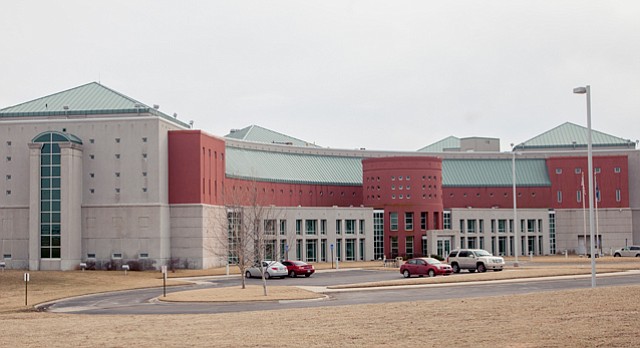July 26, 2017. Lawrence Journal-World.
After learning Wednesday of a new issue that has the county jail occasionally housing more inmates than its 186-bed capacity, Douglas County commissioners agreed a report on future jail population numbers should be shared with architects so they can update jail expansion plans.
Commissioners listened to Kansas City, Mo., consultant Allen Beck share details of his jail population forecast report before they agreed the report should be forwarded to Treanor Architects. That would be done so the firm could use the findings to update a conceptual expansion design the firm shared with commissioners in January 2016, County Commission Chairman Mike Gaughan said.
Beck was hired in February for $5,000 a month to complete the study, which found that the county’s population growth is driving an increase in the jail’s population. Beck found that the jail would need 241 beds in 2020 and 300 by 2040.
Several members of the interfaith activist group Justice Matters at the meeting opposed further work on the jail design out of concern Beck’s conclusions were premature because he only studied the impact of a single initiative meant to reduce the jail’s population.
At the meeting, Beck defended the report’s focus on the pretrial release program because it made the biggest reduction in jail population numbers. He found the program would divert 56 inmates from the jail this year, a number which would rise to 73 by 2040.
“You’ve identified the big chunk,” he said. “The rest will give you smaller numbers.”
Beck said he studied the pretrial release program because he had data on which to base conclusions. That wasn’t the case with more recent initiatives, such as the post-conviction house arrest program, he said. There were still a number of unknown factors, such as the willingness of judges, defense attorneys or prosecutors to make use of the program. That uncertainty made it difficult to estimate its outcomes, he said.
As for the behavioral health court introduced in Douglas County District Court this year or the future mental health crisis intervention center, Beck said the available data suggested they would not significantly decrease the inmate population. The behavioral health court was only serving eight people, and Johnson County was only diverting four inmates a month from its jail to its mental health facility, he said.
The county’s incarceration rate of 163.6 inmates per 100,000 residents in 2014 was lower than the national and state rates and those of the five largest counties in Kansas, six counties of similar size in neighboring or nearby states and four counties of similar size with universities, Beck said.
“You might come to the reasonable assumption you are doing a lot of things right,” he said.
Because of the county’s past efforts to reduce its jail population, new programs would have diminished results because they would often simply “shuffle” inmates from an existing program into a new one, Beck said.
Brent Hoffman was one of three Justice Matters members to question Beck’s approach. Hoffman said the study should consider the county’s attempts to speed up criminal proceedings in Douglas County District Court to reduce the time offenders spend in jail awaiting trial. He said Beck’s report did not take into account the second pro-tem judge position the County Commission has agreed to fund for 2018.
The report also should have studied the consequences of the $1.98 million in new behavioral programming the County Commission agreed to fund in 2018, Hoffman said.
“The scope of the study was limited,” he said. “It wasn’t enough.”
But new information Undersheriff Gary Bunting shared at the meeting provided urgency for commissioners to move the jail expansion design forward.
Bunting said the Douglas County Sheriff’s Office has been forced on a number of occasions in recent months to house more inmates than the jail’s capacity because of difficulties in placing inmates in out-of-county jails.
The county continues to experience greater challenges in finding beds for its overflow inmate population in other counties, Bunting said. Compounding that problem recently is the inability to place inmates other counties have accepted because those inmates have impending court dates, he said.
“We’ve had occasions when there were no beds available,” he said. “We’ve had inmates on the floor on mattresses and multiple people in the same cell. We’ve held people in booking instead of moving them to housing units.”
Gaughan said the new information highlighted the need to make the jail safer for staff and inmates.
The conceptual design Treanor shared of the jail’s expansion in January 2016 would provide an additional 120 beds at the estimated cost of $30 million. That bed total is close to the 300 beds that Beck said the county would need by 2040. However, Beck suggested significant changes in how those beds should be allocated. For example, Beck found more beds would be needed for male minimum- and maximum security pods and fewer beds would be needed for female inmates.
Bunting said jail staff was involved in Beck’s study and concurred with its findings.
Moving forward with the jail expansion design would not stop the county from exploring new programs to reduce inmate numbers, Gaughan said
“We need to do both,” he said. “We have to continue to be aggressive in finding alternatives to incarceration, but we also have to provide an adequate facility for the safety of our jail staff and inmates.”
View original article.






